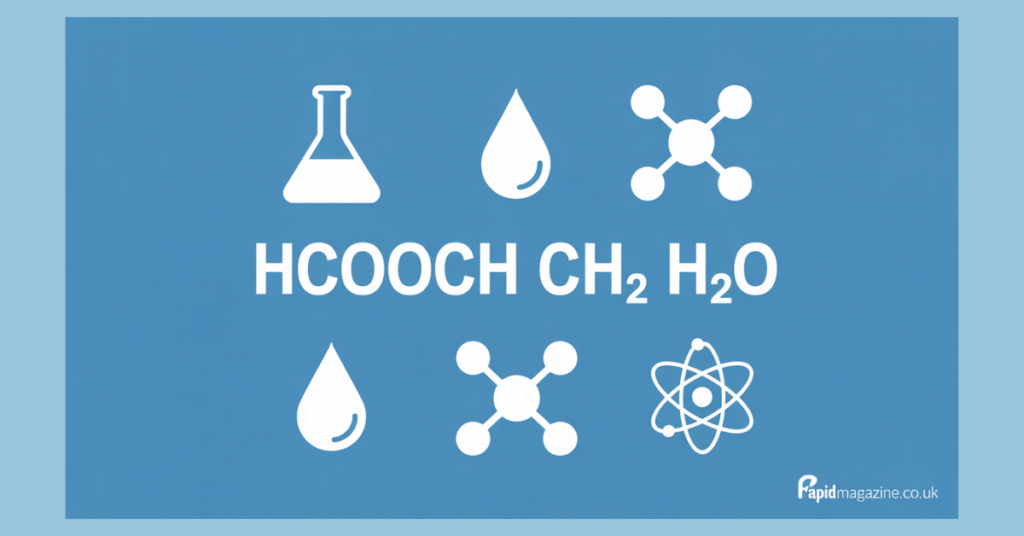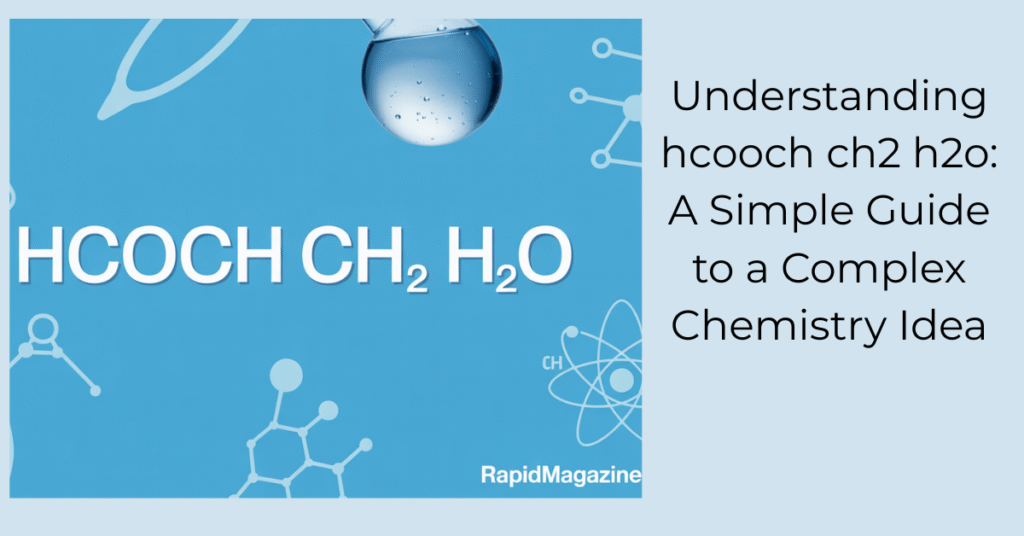Chemistry often appears to be a world of strange letters and numbers. At first glance, formulas such as hcooch ch2 h2o look confusing. However, once we break them down into small steps, they begin to make sense. In this article, we’ll explore what this formula means, its relationship to real-life chemistry, and its significance. Don’t worry—we’ll keep things simple and fun, just like a conversation. By the end, you’ll see that chemistry is not as scary as it looks.
What Does hcooch ch2 h2o Mean?

The formula hcooch ch2 h2o looks like a mix of carbon, hydrogen, and oxygen atoms. These letters represent the building blocks of molecules. Chemists use these short codes to write chemical reactions and structures.
- HCOOCH may relate to formic acid derivatives. Formic acid is the simplest organic acid, commonly found in the stings of ants.
- CH2 usually means a group of carbon and hydrogen atoms bonded together.
- H2O is plain water, the most familiar chemical of all.
When these pieces appear together, they may describe a reaction in which formic acid, a carbon-based compound, and water interact. Although the formula appears unusual, it is connected to common topics in organic chemistry.
Why Chemistry Uses Formulas
You might wonder, “Why can’t chemists just use words instead of strange formulas like hcooch ch2 h2o?” The answer is simple. Formulas are like a universal language. A student in India, a scientist in Brazil, and a teacher in Canada can all understand the same formula. Words change from one country to another, but symbols stay the same.
Formulas save space, too. Instead of saying “a molecule with one carbon, two hydrogens, and one oxygen,” we can just write CH2O. That’s why chemists rely on formulas—it makes science faster and clearer.
Breaking Down the Pieces of hcooch ch2 h2o
To make things clearer, let’s split the formula:
- HCOOCH – Think of this as a formate group, related to formic acid.
- CH2 – A simple carbon-hydrogen group that shows up in almost all organic molecules.
- H2O – Our daily life friend, water.
When combined, these groups can show how molecules react with each other. This is very important in organic chemistry, where reactions between small groups create larger, more useful chemicals.
How Water Plays a Role in Reactions
The H2O in hcooch ch2 h2o is not just there by accident. Water is often a part of chemical reactions. Sometimes, water helps break molecules apart, a process known as hydrolysis. Other times, water helps form new bonds between atoms.
For example, when you digest food, water helps break down proteins, fats, and carbohydrates. Life as we know it today would not exist without water. Similarly, the water inside this formula likely plays a crucial role in the reaction process.
Everyday Examples Related to This Formula

You might think, “Okay, but what does hcooch ch2 h2o have to do with me?” Great question! Chemistry is not only for labs—it’s in your daily life.
- The formic acid part (HCOO-) is in ants and bee stings. That burning feeling? That’s formic acid at work.
- CH2 groups appear in plastics, fuels, and even the food you eat. They are everywhere.
- Water (H2O) is something you drink every day, and also the reason your body can do chemistry at all.
Although the formula appears complicated, the ingredients are very familiar in everyday life.
Why Organic Chemistry Matters
Formulas like hcooch ch2 h2o belong to organic chemistry. That’s the study of carbon-based molecules. Organic chemistry is super important because life itself is carbon-based. Proteins, fats, DNA, and sugars—all of these are organic molecules.
Learning about organic chemistry helps scientists:
- Create new medicines to cure diseases.
- Design better fuels and materials.
- Understand how life works at the smallest level.
So, even though the formula looks like a puzzle, it’s actually part of a much bigger story about life and science.
The Science of Molecules and Bonds
Every formula shows how atoms connect with each other. In hcooch ch2 h2o, the carbon, hydrogen, and oxygen atoms stick together with bonds. These bonds are like tiny glue that holds the structure.
There are single bonds, double bonds, and sometimes even triple bonds. Each type changes how the molecule behaves. For example, single bonds can rotate freely, while double bonds make molecules more rigid. That’s why a small change in bonding can turn one substance into something completely different.
Simple Analogy: Lego Blocks of Chemistry
Think of hcooch ch2 h2o as Lego pieces. Each symbol is like a block. When you snap blocks together, you make something bigger. That’s exactly how chemistry works.
- The HCOOCH block is one Lego piece.
- The CH2 block is another piece.
- The H2O block is like a connector piece that helps them fit together.
By rearranging these pieces, you can build new molecules. Just like with Legos, the number of possible structures is almost endless.
Safety and Real-World Use
Even though hcooch ch2 h2o looks harmless on paper, real chemicals must be handled carefully. Formic acid can burn your skin. Some CH2-based compounds are safe, while others are poisonous. Water is safe, of course, but in reactions, it can sometimes produce heat or gas.
This is why scientists wear gloves, goggles, and lab coats. Safety rules are very strict in chemistry labs because even simple-looking formulas can surprise you.
How Students Can Learn About It
If you’re a student trying to understand hcooch ch2 h2o, don’t feel discouraged. Chemistry is like learning a new language. At first, it feels strange, but with practice, it becomes easier.
Here are some study tips:
- Break down long formulas into small parts.
- Use flashcards for symbols and groups.
- You can “see” the structure of molecules by drawing them on paper.
- Connect the formula to real-life examples, such as water, sugar, or vinegar.
With patience, you’ll soon find that chemistry becomes fun instead of scary.
The Bigger Picture in Science
Formulas like hcooch ch2 h2o may look small, but they connect to big ideas. They help scientists:
- Explain natural processes like digestion and respiration.
- Discover new materials for technology.
- Develop eco-friendly fuels to fight climate change.
So, when you look at this formula, you’re not just looking at random letters. You’re looking at the secret code of life and progress.
FAQs About hcooch ch2 h2o
Q1: Is hcooch ch2 h2o a real chemical compound?
It looks like a shorthand form. Chemists sometimes write formulas in parts to show reactions.
Q2: Why does it include H2O?
Because water often helps molecules react, either by breaking them apart or linking them together.
Q3: Is it dangerous?
The parts of the formula can be. For example, formic acid can sting, but water is safe.
Q4: How do I read such formulas easily?
Split them into smaller groups. Learn what each group means, then put them together.
Q5: Where is this used in real life?
Formic acid is used in farming, CH2 groups are in plastics, and H2O is everywhere.
Q6: Is this important for students?
Yes! Learning about formulas like this helps students understand the basics of organic chemistry.
Conclusion: Why hcooch ch2 h2o Matters
At first sight, hcooch ch2 h2o looks like a jumble of letters. But once we break it down, it’s not so scary. It’s actually a simple way to show how molecules like formic acid, carbon groups, and water interact. This type of chemistry is closely connected to daily life, medicine, energy, and even the natural world.
So the next time you see a strange formula, remember: it’s just a code waiting to be unlocked. And once you learn the code, you’ll see how amazing the world of chemistry really is.











